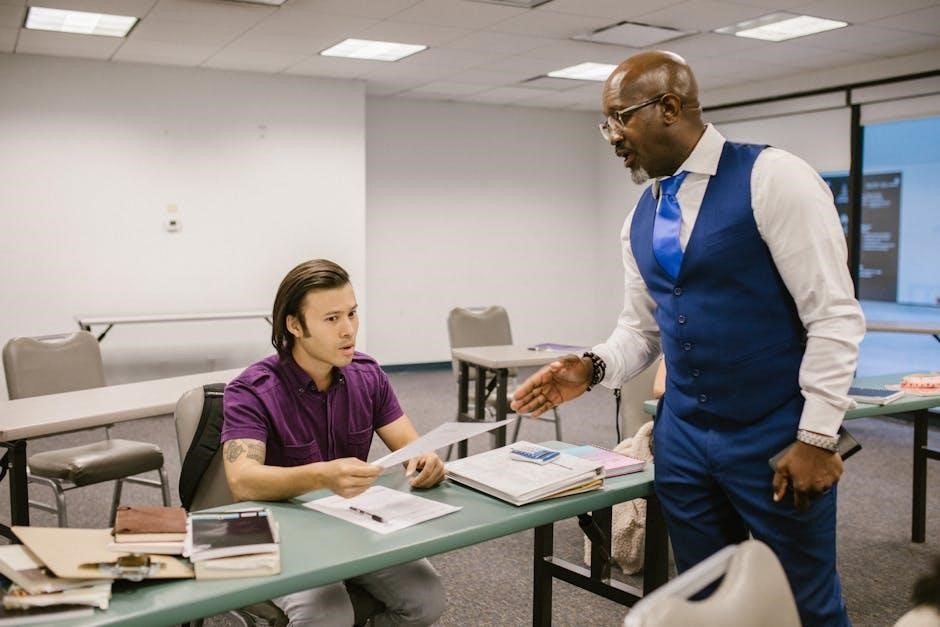special education teacher interview questions and answers pdf
Special education teacher interviews assess candidates’ skills, experience, and passion for supporting diverse learners․ This guide provides insights into common questions, answers, and preparation strategies to help candidates excel․
Overview of the Role and Its Importance
Special education teachers play a vital role in supporting students with diverse needs, creating personalized learning plans, and fostering inclusive environments․ Their work is essential for helping students overcome challenges, achieve milestones, and thrive academically and socially․ This role requires adaptability, compassion, and a commitment to empowering students with disabilities, making it a cornerstone of modern education systems․
Key Skills and Qualities Sought in Candidates
Special education teachers must possess strong communication, collaboration, and adaptability skills․ They should demonstrate a deep understanding of diverse learning needs, behavior management strategies, and IEP development․ Compassion, patience, and creativity are essential․ Candidates should also show proficiency in differentiated instruction, assistive technology, and evidence-based practices․ Strong organizational and problem-solving abilities are critical, along with a commitment to ongoing professional growth and student advocacy․
Behavioral Management Strategies
Effective behavioral management involves positive reinforcement, clear expectations, and de-escalation techniques․ Creating a structured, supportive environment helps students with diverse needs manage behaviors and focus on learning․
Common Behavioral Challenges in Special Education
Students with disabilities may exhibit disruptive behaviors, difficulty following rules, and emotional outbursts․ Challenges include inattention, impulsivity, and social interaction difficulties․ Teachers must address these issues with patience, consistency, and tailored strategies to create a supportive learning environment․
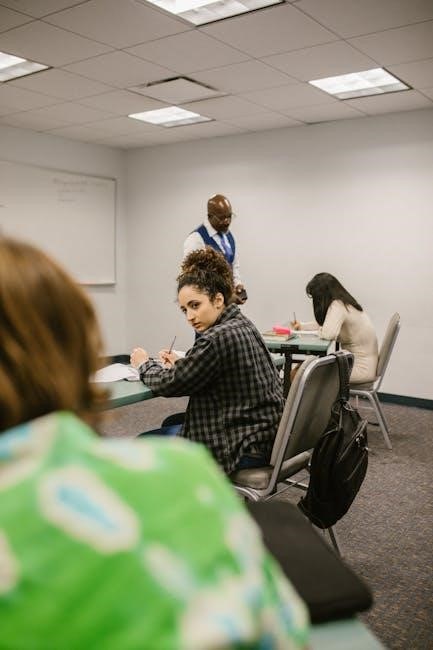
Effective Techniques for Managing Classroom Behavior
Positive reinforcement, clear expectations, and structured routines are key strategies․ Using behavior intervention plans, de-escalation techniques, and individualized support helps create a safe, respectful environment․ Consistency and adaptability ensure effective classroom management tailored to diverse student needs․

Understanding Individualized Education Programs (IEPs)
IEPs are legal documents outlining a student’s specific needs, goals, and support services․ They require collaboration with parents and professionals to ensure personalized learning and progress monitoring․
Developing and Implementing IEPs
Developing and implementing IEPs requires collaboration with parents, educators, and professionals to create tailored goals and support services for students with special needs․ The process involves assessing student strengths, identifying challenges, and setting measurable objectives․ Legal requirements ensure accountability, while regular progress monitoring allows for adjustments to meet evolving needs․ Effective implementation relies on clear communication and a commitment to fostering student growth and independence․
Collaboration with Parents and Professionals
Collaboration with parents and professionals is essential for student success․ Special education teachers must communicate effectively with families, sharing progress updates and involving them in decision-making․ Working alongside therapists, administrators, and general educators ensures a cohesive support system․ Open dialogue and teamwork foster a collaborative environment, enabling tailored strategies to meet individual needs․ This partnership is vital for creating a unified approach to student growth and achievement․
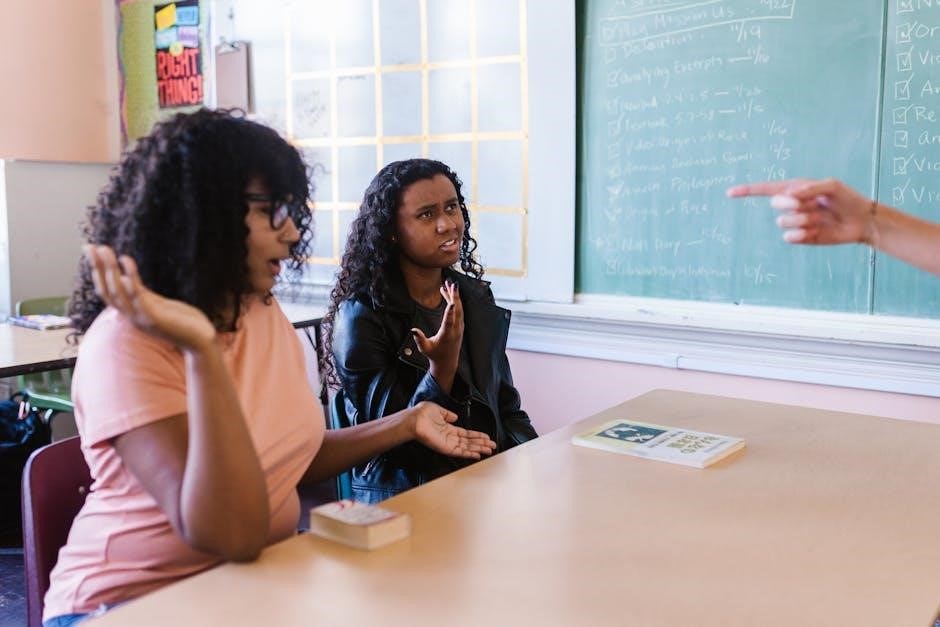
Classroom Management Tips
Creating a structured, positive environment is crucial․ Use clear expectations, positive reinforcement, and visual supports to meet diverse needs and ensure student engagement and success․

Creating a Positive and Inclusive Learning Environment
Fostering a positive and inclusive classroom involves creating a safe, respectful, and supportive space for all students․ Strategies include clear expectations, positive reinforcement, and visual supports to promote engagement․ Encouraging collaboration and using assistive technology can further enhance inclusivity․ By addressing diverse needs and celebrating individual strengths, educators create an environment where every student feels valued and empowered to succeed․
Using Positive Reinforcement and Support Plans
Positive reinforcement is a powerful tool to encourage desired behaviors and improve student outcomes․ Techniques like token systems, praise, and rewards can motivate students and reduce challenging behaviors․ Support plans, such as behavior intervention plans (BIPs), help address specific needs and provide structured guidance․ By combining these strategies, educators create a proactive environment that fosters social, emotional, and academic growth, ensuring students feel supported and empowered to succeed․
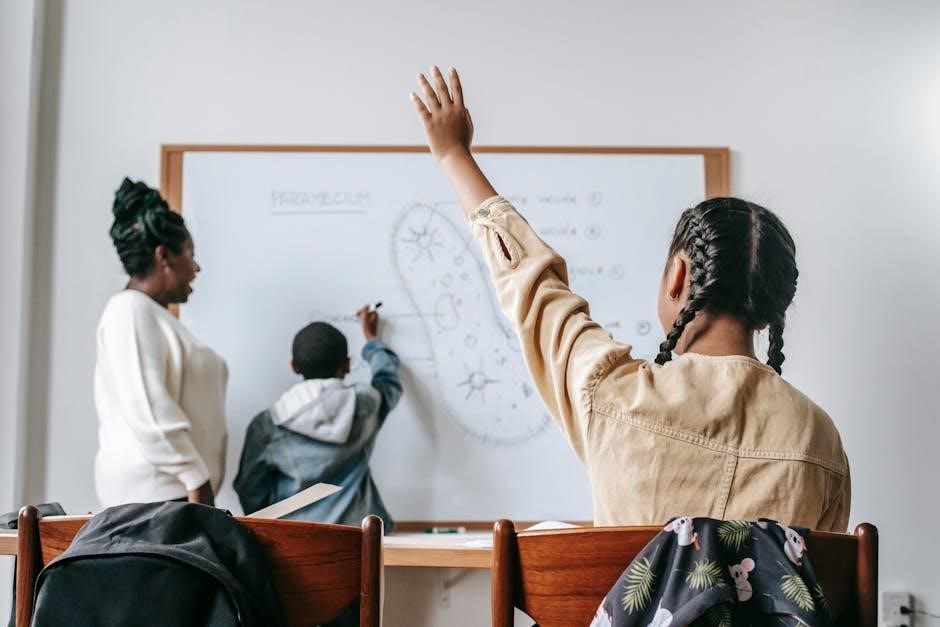
Teaching Strategies for Diverse Learners
Special education teachers use differentiated instruction, assistive technology, and tailored methods to meet individual needs, ensuring inclusive and engaging learning experiences for all students․
Differentiated Instruction and Adaptation
Differentiated instruction involves tailoring teaching methods to meet individual learning needs, ensuring each student accesses the curriculum effectively․ Special education teachers adapt strategies based on learning styles, strengths, and challenges, fostering an inclusive environment․ This approach, combined with collaboration with professionals and the use of assistive technology, supports diverse learners in achieving their educational goals․
Role of Assistive Technology in Special Education
Assistive technology empowers students with disabilities to access learning materials and participate actively in education․ Tools like text-to-speech, speech-to-text, and adaptive devices cater to diverse needs, ensuring inclusivity․ These technologies promote independence, confidence, and academic success, enabling students to reach their full potential․

Communication and Collaboration
Effective communication and collaboration with parents, therapists, and professionals are vital in special education․ Clear dialogue ensures aligned support, fostering a cohesive team effort for student success․
Effective Communication with Parents and Families
Effective communication with parents and families is crucial for student success․ Special education teachers must provide clear updates on progress, listen actively to concerns, and collaborate on goals․ Regular meetings, detailed reports, and open dialogue foster trust and alignment․ By ensuring parents feel involved and informed, teachers create a supportive partnership that enhances learning outcomes and addresses individual needs effectively․
Working with Other Professionals and Support Staff
Collaboration with therapists, administrators, and general education teachers is essential for student success․ Special education teachers must communicate effectively, share resources, and align strategies to create a cohesive support system․ Building strong relationships with support staff ensures comprehensive care for students, fostering a team-oriented approach that addresses diverse needs and promotes inclusive education․
Common Interview Questions and Answers
Interviews often focus on behavioral management, IEP development, and teaching strategies․ Questions assess your ability to handle diverse challenges and support students with special needs effectively․
Top Questions Asked in Special Education Interviews
Common questions include, “How do you handle disruptive behavior?” and “Describe your experience with IEPs․” These assess your problem-solving skills, knowledge of special education practices, and ability to adapt teaching strategies․ Questions about classroom management and collaboration with parents or professionals are also frequent, aiming to evaluate your commitment to creating inclusive learning environments and supporting diverse student needs effectively․
Example Responses to Demonstrate Expertise
When asked about behavioral management, a candidate might say, “I use positive reinforcement and clear expectations to create a structured environment․ For example, I implemented a token system that reduced disruptions by 50%․” For IEP development, they could respond, “I collaborate with parents and professionals to set measurable goals, ensuring each student’s needs are met․” These responses highlight problem-solving skills, adaptability, and a commitment to student success, showcasing expertise effectively․
Using the STAR Method for Answering Questions
The STAR method (Situation, Task, Action, Result) helps structure responses to behavioral questions․ It ensures clarity and highlights your problem-solving skills and outcomes effectively in interviews․
Structure for Crafting Compelling Responses
The STAR method provides a clear framework for answering interview questions․ Begin with the Situation by setting the context, then describe the Task or challenge you faced․ Next, outline the Action you took to address it, and conclude with the Result, highlighting the positive outcome․ This structure ensures your responses are organized, concise, and impactful, effectively showcasing your problem-solving skills and teaching experiences․
Examples of STAR Method in Action
For example, when asked about managing disruptive behavior, a candidate might respond: “In a situation where a student struggled with following classroom rules (Situation), I created a behavior support plan (Task)․ I implemented positive reinforcement strategies and individualized goals (Action)․ As a result, the student’s behavior improved, and academic engagement increased significantly (Result)․” This approach clearly demonstrates problem-solving skills and teaching effectiveness․
Preparing for the Interview
Research the school’s mission and needs, review common questions, and practice responses․ Focus on showcasing your skills, experiences, and passion for special education to stand out․
Researching the School and Position
Researching the school’s mission, values, and specific needs helps tailor your responses to their expectations․ Understanding their special education programs, student population, and staff structure allows you to highlight relevant experiences and skills․ Visit the school’s website, review their policies, and familiarize yourself with their teaching philosophies․ This preparation enables you to ask insightful questions and demonstrate how your background aligns with their goals, showing genuine interest and readiness to contribute effectively․
Practicing Responses to Common Questions
Practicing responses to common questions is crucial for special education teacher interviews․ Review potential questions, such as those about behavioral management or IEP development, and craft clear, concise answers․ Use the STAR method to structure your responses, highlighting your skills and experiences․ Align your answers with the school’s mission and student needs․ Consider using flashcards or mock interviews to refine your delivery․ This preparation ensures confidence and demonstrates your readiness to address challenges effectively․

Example Answers to Special Education Questions
Example answers demonstrate expertise in handling behavioral issues and IEP development․ Use the STAR method to structure responses, showcasing specific experiences and strategies that highlight your skills and passion․
Handling Behavioral Issues
When addressing behavioral challenges, emphasize your use of positive reinforcement, clear expectations, and de-escalation techniques․ For example, describe how you created a behavior support plan that reduced disruptions․ Highlight your ability to identify triggers and adapt strategies to meet individual needs, ensuring a safe and inclusive learning environment․ Showcase your commitment to fostering respect and resilience, demonstrating how you empower students to manage their behaviors effectively․
Experience with IEP Development
Describe your role in developing and implementing IEPs, emphasizing collaboration with parents and professionals․ Highlight how you tailor goals to meet individual needs and monitor progress․ Share examples of successful IEP outcomes, demonstrating your ability to adapt strategies and ensure student growth․ Showcase your commitment to creating personalized plans that empower students to achieve their full potential in a supportive educational environment․
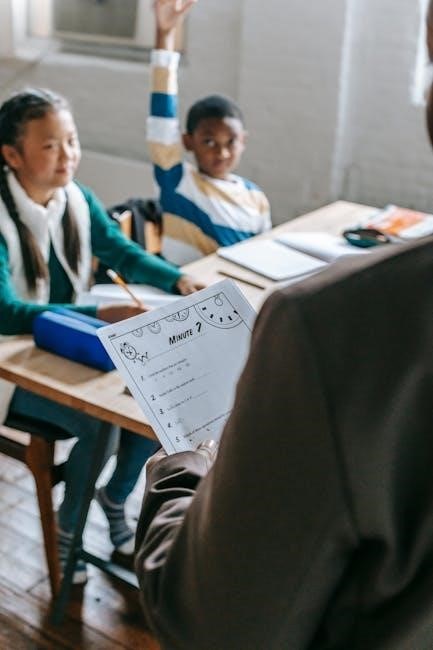
Highlighting Passion and Commitment
Express your genuine passion for special education, emphasizing your dedication to student success and empowerment․ Share experiences that reflect your commitment to fostering inclusive and supportive learning environments․
Showing Dedication to Student Success
Demonstrate your commitment to student success by sharing examples of how you empower learners with special needs․ Highlight your ability to celebrate their strengths, address challenges, and create personalized plans․ Emphasize your dedication to fostering independence and confidence, ensuring each student reaches their full potential․ Discuss how you use strategies like IEPs and positive reinforcement to support growth․ Show how your passion drives you to make a meaningful impact on their educational journey․
Discussing Professional Development
Highlight your commitment to ongoing learning and growth in special education․ Discuss workshops, courses, or certifications that enhance your teaching strategies and adaptability․ Emphasize how professional development helps you stay updated on best practices, technologies, and methodologies․ Share experiences where continuous learning improved your ability to support diverse learners․ Demonstrate how your dedication to professional growth directly benefits student outcomes and your effectiveness as an educator․
Additional Resources and Guides
Explore recommended reading, online courses, and workshops to enhance your interview preparation and professional growth in special education․ Utilize PDF guides for tailored insights and strategies․
Recommended Reading and Tools
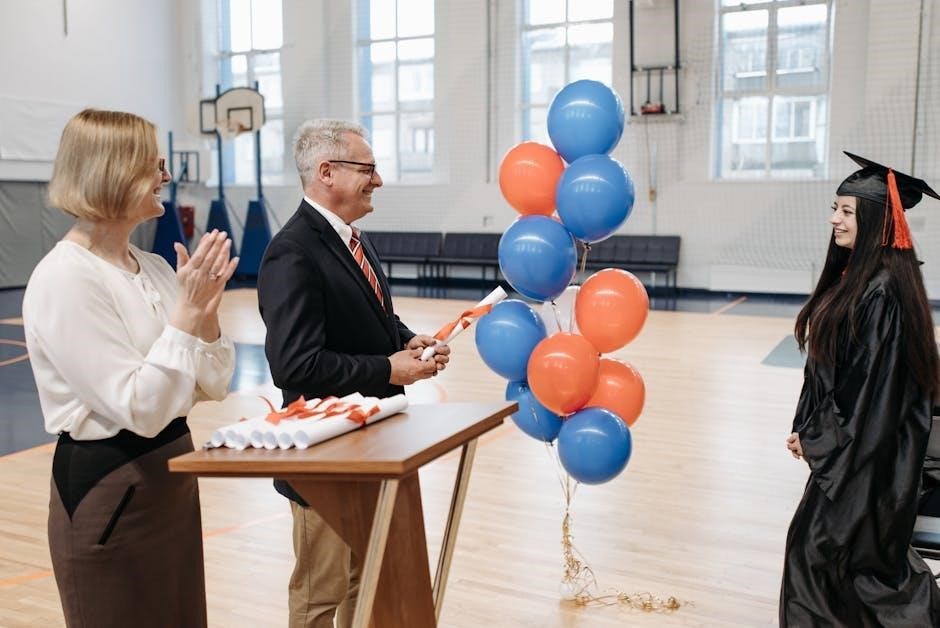
Enhance your preparation with resources like “Special Education Teacher Interview Questions and Answers PDF” and “Behavioral Interview Questions for Special Educators․” These guides offer insights into common questions, sample responses, and strategies for showcasing your expertise․ Additionally, explore online courses and workshops focused on special education interviewing skills, providing practical advice and real-world examples to strengthen your confidence and readiness for the interview process․
Online Courses and Workshops
Online courses and workshops are invaluable for preparing for special education teacher interviews․ Platforms offer specialized training on IEP development, behavioral management, and teaching strategies․ These resources provide sample questions, expert tips, and interactive exercises to refine your responses․ Courses like “Mastering Special Education Interviews” and “Teaching Strategies for Diverse Learners” equip candidates with practical insights, ensuring confidence and readiness to address interview questions effectively and professionally․
Preparing for special education teacher interviews requires dedication and insight․ By understanding key questions, showcasing your expertise, and demonstrating passion, you can confidently secure a fulfilling role in this vital field․
Final Tips for Success
Research the school, practice responses, and showcase your passion for special education․ Highlight experiences with IEPs, behavioral management, and differentiated instruction․ Use the STAR method to structure answers, demonstrating clear examples of your skills․ Emphasize collaboration with parents and professionals, and express commitment to student success․ Confidence, sincerity, and a solutions-focused mindset will leave a lasting impression, increasing your chances of securing the position․
Next Steps After the Interview
After the interview, send a thank-you note to express gratitude and reiterate your interest․ Follow up if you haven’t received a response within the expected timeframe․ Prepare for potential next steps, such as reference checks or additional evaluations․ Stay positive and persistent, as the hiring process may take time․ Continue showcasing your enthusiasm for the role and commitment to special education, ensuring you remain a strong candidate for the position․
